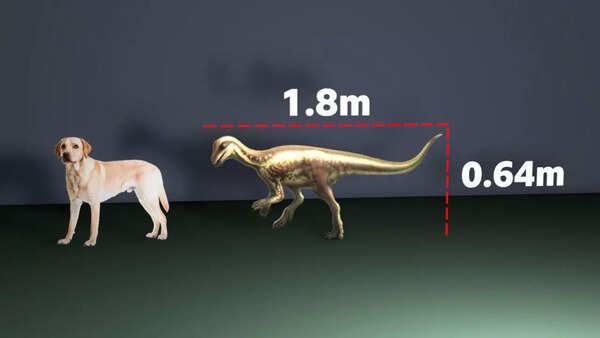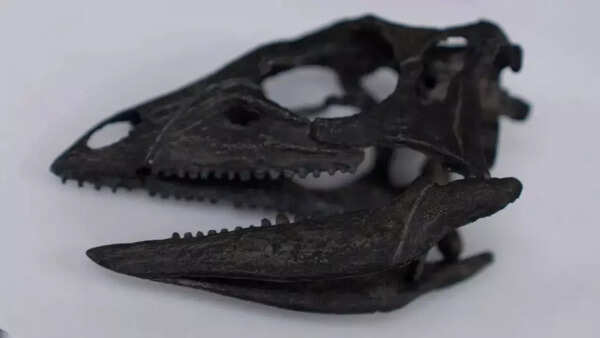Scientists have announced the discovery of a new, diminutive dinosaur species, approximately the size of a modern dog. This fascinating find sheds light on the intricate ecosystems of the Mesozoic Era, revealing how smaller dinosaurs thrived alongside colossal species.

According to a report by the BBC, the new species, Enigmacursor mollyborthwickae, has been detailed in the journal Royal Society Open Science. This dinosaur, about the size of a Labrador Retriever with half its length attributed to its tail, was initially misclassified as a Nanosaurus. The dinosaur is currently exhibited at the Natural History Museum (NHM).
Enigmacursor, meaning "puzzling runner," stood roughly 64 cm tall and 180 cm long. Its relatively small size, combined with distinctive features like larger feet and a long tail, set it apart. This dinosaur shared its habitat with giants like Stegosaurus, roaming the Earth approximately 150 million years ago.

The reclassification came after scientists revisited the original Nanosaurus specimen in the United States. The specimen proved to be incomplete, consisting mainly of a rock with bone impressions, hindering definitive identification.
Despite its small size, Enigmacursor played a vital role in its ecosystem, scurrying around the feet of enormous herbivores and carnivores. This discovery offers valuable insights into the adaptive strategies that allowed smaller species to survive and flourish alongside their massive contemporaries, painting a picture of a complex and diverse prehistoric world.

This exciting find significantly enriches our understanding of dinosaur diversity, evolution, and behavior. It challenges the long-held assumption that only large dinosaurs dominated ancient ecosystems. The existence of Enigmacursor demonstrates the important roles smaller species played in these environments and provides crucial data for further exploration of deep-time evolutionary relationships.
Newer articles
Older articles
 Rishabh Pant Revolutionizing Cricket, Says Greg Chappell
Rishabh Pant Revolutionizing Cricket, Says Greg Chappell
 Toxic Workplace Warning Signs: Spot the Red Flags Early
Toxic Workplace Warning Signs: Spot the Red Flags Early
 Moto G54 Price Slashed in India: Check Out the Discounted Rates and Specs
Moto G54 Price Slashed in India: Check Out the Discounted Rates and Specs
 Global Immunization Crisis: Millions of Children at Risk as Vaccine Coverage Lags, Study Reveals
Global Immunization Crisis: Millions of Children at Risk as Vaccine Coverage Lags, Study Reveals
 IRCTC Launches AI Chatbot 'AskDisha 2.0' to Revolutionize Train Ticket Booking and Customer Service
IRCTC Launches AI Chatbot 'AskDisha 2.0' to Revolutionize Train Ticket Booking and Customer Service
 Indian Astronaut Shukla Arrives at ISS, Ushering in New Era for Space Program
OR
India Celebrates as Shukla Reaches ISS, Advancing Ambitious Space Goals
Indian Astronaut Shukla Arrives at ISS, Ushering in New Era for Space Program
OR
India Celebrates as Shukla Reaches ISS, Advancing Ambitious Space Goals
 Google Unveils Plan to Safeguard 2024 Indian Elections: Tackling Misinformation, AI Deepfakes, and Promoting Voter Access
Google Unveils Plan to Safeguard 2024 Indian Elections: Tackling Misinformation, AI Deepfakes, and Promoting Voter Access
 YouTuber 'Finance With Sharan' Hacked: Account Security Lessons Learned After Bitcoin Scam Live Stream
YouTuber 'Finance With Sharan' Hacked: Account Security Lessons Learned After Bitcoin Scam Live Stream
 Skin Cancer Alert: How to Recognize Suspicious Moles and Early Warning Signs
Skin Cancer Alert: How to Recognize Suspicious Moles and Early Warning Signs
 20 Minutes to a Healthier Brain and Body: Neurologist's Simple Strategies to Combat Cholesterol, Blood Pressure, and Dementia
20 Minutes to a Healthier Brain and Body: Neurologist's Simple Strategies to Combat Cholesterol, Blood Pressure, and Dementia